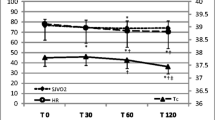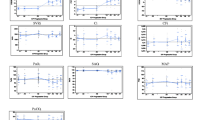Summary
In five head-injured patients with cerebral contusion and oedema in whom it was not possible to control intracranial pressure (ICP) (ICP>20 mmHg) by artificial hyperventilation (PaCO2 level 3.5–4.0 kPa) and barbiturate sedation, indomethacin was used as a vasoconstrictor drug. In all patients, indomethacin (a bolus injection of 30 mg, followed by 30 mg/h for seven hours) reduced ICP below 20 mmHg for several hours. Studies of cerebral circulation and metabolism during indomethacin treatment showed a decrease in CBF at 2h. After 7h, ICP remained below 20 mmHg in three patients, and these still had reduced CBF. In the other patients a return of ICP and CBF to pretreatment levels was observed. In all patients indomethacin treatment was followed by a fall in rectal temperature. These results suggest that indomethacin due to its cerebral vasoconstrictor and antipyretic effect should be considered as an alternative for treatment of ICP-hypertension in head-injured patients.
Similar content being viewed by others
References
Awad I, Little JR, Lucas F, Skrinska V, Slugg R, Lesser RP (1983) Modification of focal cerebral ischaemia by prostacyclin and indomethacin. J Neurosurg 58: 714–719
Becker DP, Miller JD, Ward JD, Greenberg RP, Young HF, Sakalas R (1977) The outcome from severe head injury with early diagnosis and intensive management. J Neurosurg 47: 491–502
Benedek G, Toth-Daru P, Janáky J, Hortobágyi A, Obal Jr F, Colner-Sasi K (1987) Indomethacin is effective against neurogenic hyperthermia following cranial trauma or brain surgery. Can J Neurol Sci 14: 145–148
Changaris DG, McGraw CP, Richardson JD, Garretson HD, Arpin EJ, Shields CB (1987) Correlation of cerebral perfusion pressure and glasgow coma scale to outcome. J Trauma 27: 1007–1012
Cold GE, Enevoldsen EM, Malmros R (1975) The prognostic value of continuous intraventricular pressure recording in unconscious brain-injured patients under controlled ventilation. In: Lundberg N, Pontén U, Brock M (eds) Intracranial pressure II. Springer, Berlin Heidelberg New York, pp 517–521
Dahlgren N, Nilsson B, Sakabe T, Siesjö BK (1981) The effect of indomethacin on cerebral blood flow and oxygen consumption in the rat at normal and increased carbon dioxide tensions. Acta Physiol Scand 111: 475–485
Dempsey RJ, Roy MW, Meyer KL, Donaldson DL (1985) Indomethacin-mediated improvement following middle cerebral artery occlusion in cats. Effects of anaesthesia. J Neurosurg 62: 874–881
Hallenbeck JM, Furlow TW (1979) Prostaglandin 12 and indomethacin prevent impairment of post-ischaemic brain reperfusion in the dog. Stroke 10: 629–637
Harris RJ, Bayhan M, Branston NM, Watson A, Symon L (1982) Modulation of the pathophysiology of primate focal cerebral ischaemia by indomethacin. Stroke 13: 17–24
Kanamaru K, Waga S, Kojima T, Fujimoto K, Itoh H (1987) Endothelium-dependent relaxation of canine basilar arteries. Stroke 18: 932–937
Kim HJ, Levasseur JE, Patterson JL, Jackson GF, Madge GE, Povlishock JT, Kontos HA (1989) Effect of indomethacin pretreatment on acute mortality in experimental brain injury. J Neurosurg 71: 565–572
Koide T, Wieloch TW, Siesjö BK (1986) Chronic dexamethasone pretreatment aggravates ischaemic neuronal necrosis. J Cereb Blood Flow Metab 6: 395–404
Miller JD, Becker DP, Ward JD, Sullival HG, Adams WE, Rosner MJ (1977) Significance of intracranial hypertension in severe head injury. J Neurosurg 47: 503–516
Miller JD, Butterworth JF, Gudeman SK, Faulkner JE, Choi SC, Selhorst JB, Harbison JW, Lutz HA, Woung HF, Becker DP (1981) Further experience in the management of severe head injury. J Neurosurg 54: 289–299
Obrist WD, Langfitt TW, Jaggi JL, Cruz J, Gennarelli TA (1984) Cerebral blood flow and metabolism in comatose patients with acute head injury. Relationship to intracranial hypertension. J Neurosurg 61: 241–253
Pichard JD, MacKenzie ET (1973) Inhibition of prostaglandin synthesis and the response of baboon cerebral circulation to carbon dioxide. Nature New Biol 245: 187–188
Robertson CS, Narayan RK, Gokaslan ZL, Pahwa R, Grossman RG, Caram P, Allen E (1989) Cerebral arteriovenous oxygen difference as an estimate of cerebral blood flow in comatose patients. J Neurosurg 70: 222–230
Rosner MJ (1987) Cerebral perfusion pressure: Link between intracranial pressure and systemic circulation. In: Wood JH (ed) Cerebral blood flow. McGraw-Hill Book Company, pp 425–448
Sakabe T, Siesjö BK (1979) The effect of indomethacin on blood flow metabolism couple in the brain under normal, hypercapnic and hypoxic conditions. Acta Physiol Scand 107: 283–284
Sasaki T, Nakagomi T, Kirino T, Tamura A, Noguchi M, Saito I, Takakura K (1988) Indomethacin ameliorates ischaemic neuronal damage in the gerbil hippocampal CA 1 sector. Stroke 19: 1399–1403
Saul TG, Ducker TB (1982) Effect of intracranial pressure monitoring and aggressive treatment on mortality in severe head injury. J Neurosurg 56: 498–503
Shapira Y, Davidson E, Weidenfeld Y, Cotev S, Shohami E (1988) Dexamethasone and indomethacin do not affect brain oedema following head injury in rats. J Cereb Blood Flow Metab 8: 395–402
Shigeno S, Fritschka E, Shigeno T, Brock M (1985) Effects of indomethacin on rCBF during and after focal cerebral ischaemia in the rat. Stroke 16: 235–240
Shohami E, Shapira Y, Sidi A, Cotev S (1987) Head injury induces increased prostaglandin synthesis in rat brain. J Cereb Blood Flow Metab 7: 58–63
Sutherland G, Lesiuk H, Bose R, Sima A (1988) Effect of mannitol, nimodipine, and indomethacin singly or in combination on cerebral ischaemia in rats. Stroke 19: 571–578
Suzuka T, Mabe H, Nagai H (1989) Role of arachidonic acid metabolites on development of ischaemic cerebral oedema in rat middle cerebral artery occlusion. J Cereb Blood Flow Metab 9 [Suppl 1] S 89
Troupp H (1967) Intraventricular pressure in patients with severe brain injuries. J Trauma 7: 875–883
Vapalahti M, Troupp H, Heiskanen O (1969) Extremely severe brain injuries treated with hyperventilation and ventricular drainage. In: Brock M, Fieschi C, Ingvar DH, Lassen NA, Schurmann K (eds) Cerebral blood flow. Springer, Berlin Heidelberg New York, pp 266–267
Ward JD, Becker DP, Miller JD, Choi SC, Marmarou A, Wood C, Newlon PG, Keenan R (1985) Failure of prophylactic barbiturate coma in the treatment of severe head injury. J Neurosurg 62: 383–388
Ward JD, Choi A, Marmarou A, Moulton R, Muizelaar JP, DeSalles A, Becker DP, Kontos HA, Young HF (1989) Effect of prophylactic hyperventilation on outcome in patients with severe head injury. In: Hoff JT, Betz AL (eds) Intracranial pressure VII. Springer, Berlin Heidelberg New York, pp 630–633
Wennmalm Å, Eriksson S, Wahren J (1981) Effect of indomethacin on basal and carbon dioxide stimulated cerebral blood flow in man. Clin Physiol 1: 227–234
Wennmalm Å, Carlsson I, Edlund A, Eriksson S, Kaijser L, Nowak J (1984) Central and peripheral haemodynamic effects of non-steroidal anti-inflammatory drugs in man. Arch Neurol [Suppl 7]: 350–359
Yen MH, Lee SH (1987) Effects of cyclooxygenase and lipoxygenase inhibitors on cerebral oedema induced by freezing lesions in rats. Europ J Pharmacol 144: 369–373
Öhrström J, Jensen K, Nissen I, Bünemann L, Haase J (1989) Effect of indomethacine on cerebral blood flow at hypo-, normo- and hypercapnia in man. Scand Neurosurg Soc, Umeå, Sweden, abstract 25
Author information
Authors and Affiliations
Rights and permissions
About this article
Cite this article
Jensen, K., Öhrström, J., Cold, G.E. et al. The effects of indomethacin on intracranial pressure, cerebral blood flow and cerebral metabolism in patients with severe head injury and intracranial hypertension. Acta neurochir 108, 116–121 (1991). https://doi.org/10.1007/BF01418518
Issue Date:
DOI: https://doi.org/10.1007/BF01418518




